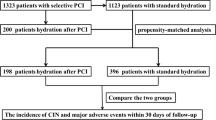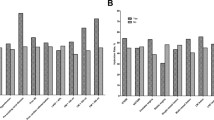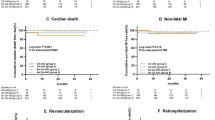Summary
Contrast mediuminduced nephropathy (CIN) is a serious complication with increasing frequency and an unfavorable prognosis. Previous analyses of surrogate parameters have suggested beneficial effects of hemodialysis that are assessed in this randomized clinical trial.
We performed a prospective single-center trial in 424 consecutive patients with serum creatinine concentrations between 1.3– 3.5 mg/dl who underwent elective coronary angiography. Patients were randomized to one of three treatment strategies with all patients receiving pre- and postprocedural hydration: One group received no additional therapy, patients in the second group were hemodialyzed once, and the third group received oral N-acetylcysteine. The frequency of CIN (defined as an increase in serum creatinine ≥0.5 mg/dl) from 48 to 72 h after catheterization was 6.1% in the hydration-only group, 15.9% with hemodialysis treatment, and 5.3% in the N-ACC group (intention-to-treat analysis; P = 0.008). There were no differences between the treatment groups with regard to increased (≥ 0.5 mg/dl) serum creatinine concentrations after 30–60 days (4.8%, 5.1%, and 3.1%, respectively; P = 0.700). Analyses of long-term follow-up (range 63 to 1316 days) by Cox regressions models of the study groups found quite similar survival rates (P = 0.500). In contrast to other (retrospective) studies, long-term survival of patients with vs those without CIN within 72 h was not different, but patients who still had elevated creatinine concentrations at 30–60 days suffered from a markedly higher 2-year mortality (46% vs 17%, P = 0.002).
In conclusion, hemodialysis in addition to hydration therapy for the prevention of CIN provided no evidence for any outcome benefit but evidence for probable harm. Increased creatinine concentrations at 30–60 days, but not within 72 h, were associated with markedly reduced long-term survival.
Similar content being viewed by others
References
K/DOQI clinical practice guidelines for chronic kidney disease: evaluation, classification, and stratification (2002) Am J Kidney Dis 39:S1–266
USRDS 2004 annual data report (2005) Am J Kidney Dis 45:8–280
Amann B (2006) Diabetic nephropathy and ACE inhibitors. Clin Res Cardiol 95:i83–i87
Anavekar NS, McMurray JJ, Velazquez EJ et al (2004) Relation between renal dysfunction and cardiovascular outcomes after myocardial infarction. N Engl J Med 351:1285–1295
Asif A, Epstein M (2004) Prevention of radiocontrast-induced nephropathy. Am J Kidney Dis 44:12–24
Aspelin P, Aubry P, Fransson SG et al (2003) Nephrotoxic effects in highrisk patients undergoing angiography. N Engl J Med 348:491–499
Barrett BJ, Parfrey PS (2006) Clinical practice. Preventing nephropathy induced by contrast medium. N Engl J Med 354:379–386
Erley CM, Bader BD, Berger ED et al (2004) Gadolinium-based contrast media compared with iodinated media for digital subtraction angiography in azotaemic patients. Nephrol Dial Transplant 19:2526–2531
Furukawa T, Ueda J, Takahashi S et al (1996) Elimination of low-osmolality contrast media by hemodialysis. Acta Radiol 37:966–971
Gruberg L, Mintz GS, Mehran R et al (2000) The prognostic implications of further renal function deterioration within 48 h of interventional coronary procedures in patients with preexistent chronic renal insufficiency. J Am Coll Cardiol 36:1542–1548
Hoffmann U, Fischereder M, Marx M et al (2003) Induction of cytokines and adhesion molecules in stable hemodialysis patients: is there an effect of membrane material? Am J Nephrol 23:442–447
Hostetter TH (2004) Chronic kidney disease predicts cardiovascular disease. N Engl J Med 351:1344–1346
Laskey WK, Gellman J (2003) Inflammatory markers increase following exposure to radiographic contrast media. Acta Radiol 44:498–503
Lehnert T, Keller E, Gondolf K et al (1998) Effect of haemodialysis after contrast medium administration in patients with renal insufficiency. Nephrol Dial Transplant 13:358–362
Levey AS, Coresh J, Balk E et al (2003) National Kidney Foundation practice guidelines for chronic kidney disease: evaluation, classification, and stratification. Ann Intern Med 139:137–147
Levy EM, Viscoli CM, Horwitz RI (1996) The effect of acute renal failure on mortality. A cohort analysis. JAMA 275:1489–1494
Lindsay J, Canos DA, Apple S et al (2004) Causes of acute renal dysfunction after percutaneous coronary intervention and comparison of late mortality rates with postprocedure rise of creatine kinase-MB versus rise of serum creatinine. Am J Cardiol 94:786–789
Maeder M, Klein M, Fehr T et al (2004) Contrast nephropathy: review focusing on prevention. J Am Coll Cardiol 44:1763–1771
Marenzi G, Lauri G, Assanelli E et al (2004) Contrast-induced nephropathy in patients undergoing primary angioplasty for acute myocardial infarction. J Am Coll Cardiol 44:1780–1785
Marenzi G, Marana I, Lauri G et al (2003) The prevention of radiocontrast- agent-induced nephropathy by hemofiltration. The New England Journal of Medicine 349:1333–1340
Matzkies FK, Reinecke H, Tombach B et al (2000) Influence of dialysis procedure, membrane surface and membrane material on iopromide elimination in patients with reduced kidney function. Am J Nephrol 20:300–304
McCullough PA, Wolyn R, Rocher LL et al (1997) Acute renal failure after coronary intervention: incidence, risk factors, and relationship to mortality. Am J Med 103:368–375
Nallamothu BK, Shojania KG, Saint S et al (2004) Is acetylcysteine effective in preventing contrast-related nephropathy? A meta-analysis. Am J Med 117:938–947
Reinecke H, Trey T, Matzkies F et al (2003) Grade of chronic renal failure, and acute and long-term outcome after percutaneous coronary interventions. Kidney Int 63:696–701
Rihal CS, Textor SC, Grill DE et al (2002) Incidence and prognostic importance of acute renal failure after percutaneous coronary intervention. Circulation 105:2259–2264
Rudnick MR, Goldfarb S (2003) Pathogenesis of contrast-induced nephropathy: experimental and clinical observations with an emphasis on the role of osmolality. Rev Cardiovasc Med 4(Suppl 5):S28–S33
Russo D, Minutolo R, Cianciaruso B et al (1995) Early effects of contrast media on renal hemodynamics and tubular function in chronic renal failure. J Am Soc Nephrol 6:1451–1458
Smith SC Jr, Dove JT Jacobs AK et al (2001) ACC/AHA guidelines for percutaneous coronary intervention: a report of the American College of Cardiology/American Heart Association task force on practice guidelines. Circulation 103:3019–3041
Solomon R, Werner C, Mann D et al (1994) Effects of saline, mannitol, and furosemide to prevent acute decreases in renal function induced by radiocontrast agents. N Engl J Med 331:1416–1420
Tepel M, van der Giet M, Schwarzfeld C et al (2000) Prevention of radiographiccontrast- agent-induced reductions in renal function by acetylcysteine. N Engl J Med 343:180–184
van Buuren F, Horstkotte D (2006) 21th report of performance data from heart catheterization laboratories in Germany. 2003 results of a collaborative survey by the Committee of Clinical Cardiology and the Interventional Cardiology (for ECS) and Angiology Study Groups of the German Society of Cardiology-Cardiovascular Research. Clin Res Cardiol 95:383–387
Vogt B, Ferrari P, Schonholzer C et al (2001) Prophylactic hemodialysis after radiocontrast media in patients with renal insufficiency is potentially harmful. Am J Med 111:692–698
Werner D, Misfeld M, Regenfus M et al (2006) Emergency coronary angiography with gadolinium in a patient with thyrotoxicosis, pulmonary embolism and persistent right atrial thrombi. Clin Res Cardiol 95:418–421
Author information
Authors and Affiliations
Corresponding author
Additional information
This study was supported by an unrestricted research grant to the Hospital of the University of Muenster from Schering AG, Berlin, Germany.
Preliminary results of this trial have been presented as a poster on the annual congress of the European Society of Cardiology in Berlin, 2002: Reinecke H, Dieckmann T, Fleiter J, Fobker M, Matzkies F, Harz C, Schaefer R (2002) Prevention of contrast media-induced renal failure after coronary angiography – First results of the "Diuresis vs Dialysis (DVD) Study". Eur Heart J 23(Abstr Suppl):701
Rights and permissions
About this article
Cite this article
Reinecke, H., Fobker, M., Wellmann, J. et al. A randomized controlled trial comparing hydration therapy to additional hemodialysis or N-acetylcysteine for the prevention of contrast medium-induced nephropathy. Clin Res Cardiol 96, 130–139 (2007). https://doi.org/10.1007/s00392-007-0473-4
Received:
Accepted:
Published:
Issue Date:
DOI: https://doi.org/10.1007/s00392-007-0473-4




